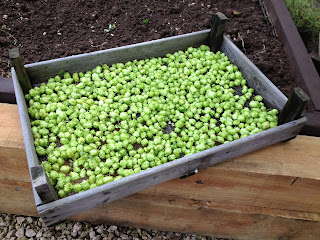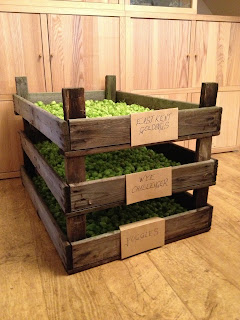As part of the legal obligation of the purchase of the land, we needed to erect approximately 250 metres of post and wire fence along the longest boundary (sods law eh!?) to the south and south west of the wood, within two calendar months of the purchase date. Initially, I'm happy to admit that I was very daunted by this prospect as 250 metres of fencing is no mean feat, even to an experienced fencing contractor. Whilst I consider myself a reasonably practical kinda' chap, this project was well out of my comfort zone, and it had to be done right-first time, and rapidly. We were aware of this obligation from the outset, as this stipulation was made within the sales particulars, which gave me plenty of time to do the sums and research.
Initially I looked at paying a local fencing contractor to do the works, but unfortunately quotes came back at around £8 per metre, which was to supply and fit high-tensile galvanised steel wire to softwood treated posts. All-in, therefore, the cost of the fencing would work out at £2000. Based upon this figure, I didn't even bother asking for quotes to supply and fit sweet chestnut fencing, which was my preferred choice for ethical, environmental and maintenance reasoning.
Sweet Chestnut (Castanea Sativa to give it its correct Latin nomenclature) is not an indigenous species to the UK, having been introduced by the Romans, but it is prolific in the south east of England where it has been coppiced for centuries to produce poles and stakes for Hop production. The reason why Sweet Chestnut is so desirable for fence posts etc, is its resistance to decomposition when in contact with the ground due the tannins within the wood. In fact, Sweet Chestnut has a comparable tannin content to Oak, which is obviously considerably more expensive and generally harder to coppice. The premise of this post and wire fence is to provide a
degree of stock-proofing to the land, whilst also providing a strong,
flexible boundary line to demark the edge of the plot, as cheaply as
possible. Unless the ground is particularly soft, this type of fence
should require nothing other than the wooden posts and the wire between,
which means that concrete is not used.
With my mind already made up for me to 'DIY' due to the costs of contracting the work, I set about obtaining quotations for supply and delivery only of the following:
11 No 6" Diameter 7' Peeled & Pointed Strainer Posts
25 No 5" Diameter 7' Peeled & Pointed Struts
140 No 4" Diameter 5'6" Peeled & Pointed Intermediate Stakes
The most favourable quotation for all of the above came from CWP Fencing (http://www.cwpfencing.co.uk) at just shy of £675 delivered to Derby from Ashford, Kent. An order was placed, and withing a week the back garden was full of chestnut posts ready to be ferried down to the woodlands as required.
I took a week of work inJune to begin the fencing, joined on alternate days by Gemma, Mark and my folks to assist me with the fencing or provide tea. Without this help and support (and a huge bowl of porridge every morning), I can safely say that the fence would not have gone up so quickly, if at all!
The erection of the fence begins by installing two of the larger 'Struts' braced with a 'strainer' towards the top, at each end of the fence line. Each of the struts are placed into a post hole which has been dug to a depth of three feet into the soil/rock and backfilled with whatever arisings created from the excavation. These strut and strainer combinations are called 'box strainers' and should look something like this;

We were rather fortunate that the exact changes in direction of our boundary had been marked out by a land surveyor before beginning the fence by means of a number of 3' long by 2" square stakes. I was personally quite keen to get these stakes replaced with the vertical strainer posts as quickly as possible because of the potential for these to be removed with ease if anyone toook umbridge to the woods being carved up and sold-off. Where there is a proposed change in direction of the fence line, a single strut is installed rather than a box strainer. The strut is the braced by roughly morticing two strainers approximately one third to half-way between ground level and the top of the post like so:
The strainers are aligned along the course of the fence, therefore it's prudent, although not essential, to use a string line to assist when doing this:
Once you've mortised the point end of the strut into the strainer, and aligned the blunt end with the direction of the fence, a narrow trench must be dug to accomodate the end of the strut. The trench need only be a spade's with, and around 8" deep at most; the end of the strut is then placed into the base of the trench. Whilst taking a break from mortising the strainer posts to accomodate the struts, a stob was fashioned from the end of a 4" intermediate post, to a length of 2' or so. This stob was offered up to the base of the strut and driven into the ground at an angle to provide a solid foundation for the strut to brace against (apologies for my crappy sketch):

After digging the first couple of post holes through reasonably easy sand, I was gutted to encounter 'hard as nails' Sandstone (yeah, that's an official geological term). It took some hellish work in the blazing sun to advance into this stuff and get all of the box strainers, directional strainers and struts into place. Having got them all into place, the next step was to install the bottom wire. I opted to use high tensile galvanised wire upon recommendation from a few folks, not to mention a good friend of mine; Craig Dasilva. It was an absolute sod to work with as my buddy Mark found out when helping; the wire takes every opportunity to twist itself around like an eel, but once its taught it wont stretch much! When it comes to fixing the wires around the box strainers (i.e. tying-off the wire) I initially started by using knots which I learned here from this guy in New Zealand (via Youtube);
Post and wire fence tips.
Once one end of the fence has been tied-off around a box strainer, a monkey strainer can be used to tighten the wire before tying another knot. Whilst the guy from NZ makes it look easy, it really isn't! My knots looked awful, so I ended up purchasing some Gripples, which are essentially a small non-return device which slides onto the wire and grips by means of a cam. Much quicker and easier, and holding firm so far!!
At this point, the most laborious task was upon us: knocking in the intermediate posts. This basically involves installing a post every 2.5 metres by way of knocking them in with a post rammer. The rammer is a simple tool, comprising a section of steel tube of 6" diameter by 3' long, with one end blanked off and two handles welded to the sides. Mark and myself took it in turns to do the donkey work, whilst the other checked the post was going in straight. Surprisingly, we did it in no time at all considering the heat we were working in and the overall length of the fence! Because we were on a bit of a roll at this point, the second length of wire went up before sunset as well:



In the last photo, you may notice the addition of a little grey Ferguson tractor, which arrived midway through the works. Sadly it was too late for the bulk of the hard work, but 'Porter' was still able to help with hauling large numbers of intermediate posts up to the top of the woodland. More info to come later in the year...
Right, back to the fencing.
Now both the upper and lower wires were in position, all that remained was the addition of three further wires to finalise it, as well as the temporary erection of the gateway fence and gate posts. The three wires were installed as per the first two and then tacked into position utilising staples. It is important not to drive the staples all the way into the posts, thereby nipping the wire, as the wire needs to be able to run freely to allow for expansion and contraction. If the wires are abraded by the staples, they will eventually lose the galvanised coating, thereby prematurely rusting the wire.
That's about it for the fencing to be honest. The next project will be purchasing and installing the gates! I'll leave you with a photo of the fence in its completed state:










































